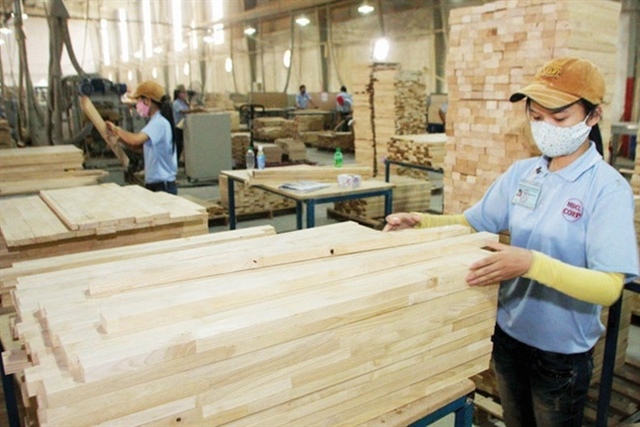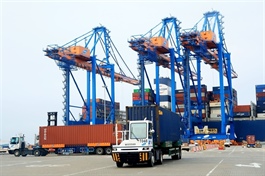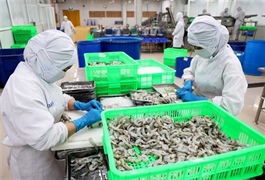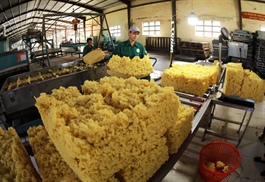Wood industry eyes positive signals in early 2025
Wood industry eyes positive signals in early 2025
Figures from Foreign Trade Agency under Ministry of Industry and Trade show that Vietnam’s export value of wood and wood products in the first half of January reached $738.8 million, a 15.6 per cent jump on-year.
Tran Lam Son, founder of southern-based Thien Minh Furniture, said that the company had orders flooding in, with its two major markets of the EU and the US showing steady growth.

Photo: baodautu.vn |
“Customers now require fast delivery to meet the high demand for 2025 spring-summer shopping season, so the company needs to constantly increase production capacity to keep up with schedules,” said Son.
According to Son, since mid-Q4/2024, companies in the industry have adapted to the buying patterns of customers, where orders are divided into smaller batches based on sales schedules.
Thanks to digital transformation and technological innovation, many companies now can produce and deliver products quickly, meeting market demands efficiently.
After experiencing a significant growth spike in 2022, the wood industry faced a severe ‘order shortage’ due to economic downturns in many regions, high inventory levels, and rising shipping costs.
At one point, order volumes declined by 40-60 per cent, and many factories had to scale back operations.
With years of market experience, businesses recognise that the scale of the industry will not shrink, but continue to grow. Thien Minh Furniture has been working hard to adapt and retain workers to seize the opportunities when the market recovers.
Meanwhile, Lai Tri Moc, CEO of Vietnam Housewares, a leading manufacturer of furniture, handwoven products and ceramic home decor, said that the opportunities for export of wood products and handicrafts were significant.
“Cross-border e-commerce platforms are rapidly growing, creating opportunities for Vietnamese businesses to trade in B2C form with end consumers globally,” said Moc.
Due to the nature of materials and product size, shipping costs often make up a large portion of the price of wood and furniture products. Industry associations have therefore gathered export companies to collect production data for each market and negotiate shipping rates with shipping companies to secure the best prices, enhancing the competitiveness of Vietnamese wood and furniture products.
“Unless there are sudden changes, the wood and furniture industry can achieve an export growth rate of 20 per cent this year, and many businesses have set a growth target of 20-30 per cent,” said Son from Thien Minh Furniture.
The Department of Forestry under the Ministry of Agriculture forecasts a positive outlook for the export of wood and wood products in 2025, with an export target of nearly $18 billion. In 2024, Vietnam brought in $16.25 billion, up 20.3 per cent on-year, from export of wood and wood products.
To reach the $18 billion export target, Ngo Sy Hoai, vice president and general secretary of Vietnam Timber and Forest Products Association, noted that trade promotion efforts are crucial.
Along with this, the Ministry of Industry and Trade (MoIT) and the Ministry of Agriculture and Rural Development should implement more policies to encourage businesses to participate in trade fairs and scale up trade promotion in the forthcoming period.
Hoai hopes the MoIT will strongly convey the ‘message’ that ‘Vietnam’s wood industry says no to illegal wood’ on the global market to enhance competitiveness.
Additionally, a positive development is that the EU has extended the deadline for implementing the Anti-Deforestation Regulation to December 30 for large businesses, and June 30, 2026, for micro and small businesses, allowing Vietnamese companies to mitigate pressures.
According to To Viet Chau, deputy director general of International Cooperation Department, the agriculture and forestry sector now has more time to adjust its strategies and supply chains.
Chau suggested companies in the sector to take advantage of this time to optimise costs, invest in technology, and undergo digital transformation to increase productivity and competitiveness.
Minisries also advise companies to prepare for meeting the greenhouse gas emission reduction standards set by the EU from 2027 onwards.
“Increasing creativity, design, and branding is also crucial to enhance product value and reduce dependence on major markets. At the same time, businesses should proactively develop sustainable raw material sources and plan for expanding production scale and seeking new markets,” Chau said.























